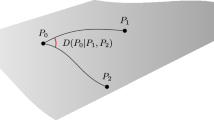Abstract
Phylogenetic networks are a generalization of evolutionary or phylogenetic trees that are used to represent the evolution of species which have undergone reticulate evolution. In this paper we consider spaces of such networks defined by some novel local operations that we introduce for converting one phylogenetic network into another. These operations are modeled on the well-studied nearest-neighbor interchange operations on phylogenetic trees, and lead to natural generalizations of the tree spaces that have been previously associated to such operations. We present several results on spaces of some relatively simple networks, called level-1 networks, including the size of the neighborhood of a fixed network, and bounds on the diameter of the metric defined by taking the smallest number of operations required to convert one network into another. We expect that our results will be useful in the development of methods for systematically searching for optimal phylogenetic networks using, for example, likelihood and Bayesian approaches.










Similar content being viewed by others
References
Allen B, Steel M (2001) Subtree transfer operations and their induced metrics on evolutionary trees. Ann Comb 5:1–15
Baroni M, Grünewald S, Moulton V, Semple C (2005) Bounding the number of hybridisation events for a consistent evolutionary history. J Math Biol 51(2):171–182
Billera LJ, Holmes SP, Vogtmann K (2001) Geometry of the space of phylogenetic trees. Adv Appl Math 27(4):733–767
Bordewich M, Semple C (2005) On the computational complexity of the rooted subtree prune and regraft distance. Ann Comb 8(4):409–423
Cardona G, Rossello F, Valiente G (2009) Comparison of tree-child phylogenetic networks. IEEE/ACM Trans Comput Biol Bioinform (TCBB) 6(4):552–569
Cardona G, Llabres M, Rosselló F, Valiente G (2011) Comparison of galled trees. IEEE/ACM Trans Comput Biol Bioinform (TCBB) 8(2):410–427
Chen T, Skiena SS (1996) Sorting with fixed-length reversals. Discret Appl Math 71(1):269–295
DasGupta B, He X, Jiang T, Li M, Tromp J, Zhang L (1997) On distances between phylogenetic trees. In: Proceedings of the eighth annual ACM-SIAM symposium on discrete algorithms. Society for industrial and applied mathematics, pp 427–436
Day WH (1983) Properties of the nearest neighbor interchange metric for trees of small size. J Theor Biol 101(2):275–288
Ding Y, Grünewald S, Humphries P (2011) On agreement forests. J Comb Theory Ser A 118(7):2059–2065
Gambette P, Huber K (2012) On encodings of phylogenetic networks of bounded level. J Math Biol 65(1):157–180
Gambette P, Berry V, Paul C (2009) The structure of level-k phylogenetic networks. In: Proceedings of combinatorial pattern matching. Springer, New York, pp 289–300
Gambette P, Berry V, Paul C (2012) Quartets and unrooted phylogenetic networks. J Bioinform Comput Biol 10:04
Gordon K, Ford E, John KS (2013) Hamiltonian walks of phylogenetic treespaces. IEEE/ACM Trans Comput Biol Bioinform 10(4):1076–1079
Gusfield D (2014) ReCombinatorics: the algorithmics of ancestral recombination graphs and explicit phylogenetic networks. MIT Press, New York
Huber KT, Moulton V (2013) Encoding and constructing 1-nested phylogenetic networks with trinets. Algorithmica 66(3):714–738
Huber KT, van Iersel L, Kelk S, Suchecki R (2011) A practical algorithm for reconstructing level-1 phylogenetic networks. IEEE/ACM Trans Comput Biol Bioinform (TCBB) 8(3):635–649
Humphries P, Wu T (2013) On the neighborhoods of trees. IEEE/ACM Trans Comput Biol Bioinform 10:721–728
Huson DH, Rupp R, Scornavacca C (2010) Phylogenetic networks: concepts algorithms and applications. Cambridge University Press, Cambridge
Jansson J, Nguyen NB, Sung WK (2006) Algorithms for combining rooted triplets into a galled phylogenetic network. SIAM J Comput 35(5):1098–1121
Jin G, Nakhleh L, Snir S, Tuller T (2006) Maximum likelihood of phylogenetic networks. Bioinformatics 22(21):2604–2611
Jin G, Nakhleh L, Snir S, Tuller T (2007) Inferring phylogenetic networks by the maximum parsimony criterion: a case study. Mol Biol Evol 24(1):324–337
Keijsper J, Pendavingh R (2014) Reconstructing a phylogenetic level-1 network from quartets. Bull Math Biol 76:2517–2541
Lemey P, Salemi M, Vandamme AM (2009) The phylogenetic handbook: a practical approach to phylogenetic analysis and hypothesis testing. Cambridge University Press, Cambridge
Li M, Tromp J, Zhang L (1996) On the nearest neighbour interchange distance between evolutionary trees. J Theor Biol 182(4):463–467
Moore GW, Goodman M, Barnabas J (1973) An iterative approach from the standpoint of the additive hypothesis to the dendrogram problem posed by molecular data sets. J Theor Biol 38(3):423–457
Moulton V, Wu T (2015) A parsimony-based metric for phylogenetic trees. Adv Appl Math 66:22–45
Nakhleh L (2010) A metric on the space of reduced phylogenetic networks. IEEE/ACM Trans Comput Biol Bioinform (TCBB) 7(2):218–222
Radice R (2011) A Bayesian approach to phylogenetic networks. PhD thesis, University of Bath
Robinson DF (1971) Comparison of labeled trees with valency three. J Comb Theory Ser B 11(2):105–119
Rosselló F, Valiente G (2009) All that glisters is not galled. Math Biosci 221(1):54–59
Semple C, Steel M (2003) Phylogenetics. Oxford University Press, Oxford
Semple C, Steel M (2006) Unicyclic networks: compatibility and enumeration. IEEE/ACM Trans Comput Biol Bioinform (TCBB) 3(1):84
Strimmer K, Moulton V (2000) Likelihood analysis of phylogenetic networks using directed graphical models. Mol Biol Evol 17(6):875–881
Swofford DL, Olsen GJ, Waddell PJ, Hillis DM (1996) Phylogenetic inference. In: Hillis DM, Moritz C, Mable BK (eds) Molecular systematics, 2nd edn. Sinauer Associates, Inc, Sunderland, Massachusetts, USA, pp 407–514
Yu Y, Dong J, Liu KJ, Nakhleh L (2014) Maximum likelihood inference of reticulate evolutionary histories. Proc Natl Acad Sci 111(46):16448–16453
Acknowledgments
The authors thank the organizers of the workshop “Utilizing Genealogical Phylogenetic Networks in Evolutionary Biology: Touching the Data” at the Lorentz Center (the Netherlands) where the ideas for this paper were first discussed. We also thank the anonymous referee for very careful reading and helpful suggestions on the first version of this manuscript.
Author information
Authors and Affiliations
Corresponding author
Additional information
S. Linz was partially supported by a Marie Curie International Outgoing Fellowship within the 7th European Community Framework Program.
Rights and permissions
About this article
Cite this article
Huber, K.T., Linz, S., Moulton, V. et al. Spaces of phylogenetic networks from generalized nearest-neighbor interchange operations. J. Math. Biol. 72, 699–725 (2016). https://doi.org/10.1007/s00285-015-0899-7
Received:
Revised:
Published:
Issue Date:
DOI: https://doi.org/10.1007/s00285-015-0899-7
Keywords
- Phylogenetic networks
- Spaces of phylogenetic trees
- Phylogenetic tree metrics
- Nearest-neighbor interchange (NNI)




